|
By 1851 Walsall's population had more than doubled since
the beginning of the century, rising from 10,399 in 1801 to
26,816 in 1851. This was typical of most of the towns in the
Black Country because large numbers of people moved into the
area seeking employment in the many local industries.
Inevitably this led to overcrowding, poor living conditions,
and poor sanitation. All of which had to be dealt with in
the fullness of time. Convicts on the Loose Frederick
Willmore describes an interesting incident in his 'History
of Walsall' which took place in the winter of 1843. The
'Albion' coach was transporting a gang of convicts through
Walsall on their way to Portland prison. As the coach made
its way along Bloxwich Road, the horses took fright near
Pratt's Bridge and dashed at full speed into the centre of
the town. In Park Street the coach collided with the
carriage belonging to Mr. Perks, the sheriff's officer.
It overturned and killed the coachman, and Mr. Illidge, Deputy
Governor of Chester Gaol. In the confusion that followed,
the convicts were supplied with files by some friendly
people in the crowd. They continued their journey, and on
the way managed to liberate themselves. At Dunsmore Heath
they overpowered their guards, set the horses free, and
fled. Although most were recaptured, two were never found.
The incident led to other, and safer means of transporting
criminals from one place to another.
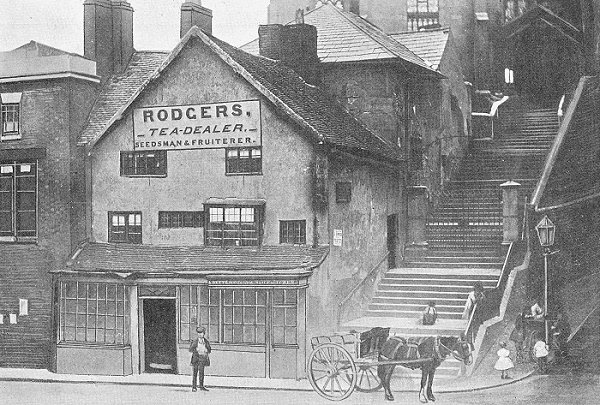
Upper Rushall Street and St. Matthew's
Church steps. From the 1899 Walsall Red Book. By the late
1890s, Rogers' shop had been demolished and
replaced by a fine building that survived until
around 1950. |
The
Mechanics’ Institute
The Mechanics’ Institute opened in 1839
in Freer Street with around 100 members, under the
presidency of Richard James, who is listed in White’s
Staffordshire Directory of 1851 as a merchant and factor,
with a business in Bridgeman Place. The institute was
founded to improve the mechanical skill, and the moral
character of the working classes, and consisted of a library
and a reading room. The annual subscription was ten
shillings. Sadly it had a short life, after becoming
embroiled in local politics, even though it was a
non-political and non-sectarian organisation.
The institute was openly supported by
radical Walsall Liberal M.P. Francis Finch of The Hollies,
Great Barr, a banker with a business in Bridge Street. The
institute’s secretary was Joseph Hicken who became secretary
of the Political Union for Walsall in 1830, and secretary to
the Anti-Corn Law League in 1838. The Corn Laws, introduced in 1815 were hated by many because they only
benefitted landowners, and caused a great increase in the
price of corn. The local Tories, who supported the Corn
Laws, were determined to destroy the institute, and refused
to allow their employees to become members.
After two years the membership had
fallen to 35, and after incurring a considerable amount of
debt, the institute closed in November 1841.

The Bridge. From W. Henry Robinson's
Guide to Walsall, 1889.
Swimming Baths
Walsall’s first public baths, the
Vicarage Water Baths in Dudley Street, opened in 1850, and
stood on the site of St. Matthew’s Quarter Car Park,
opposite Bath Street, which was named after the baths. The baths
were established by Thomas Gameson, with water from the
natural springs known as ‘The Spouts’. The building
contained a swimming bath, a shower, and several slipper
baths. It opened on week days from six o’clock in the
morning until nine o’clock in the evening, and on Saturdays
from six o’clock in the morning until ten o’clock at night. There was an unsupervised
department for men, and a ladies department with a female
attendant. The water was steam heated and kept at a suitable
temperature. In 1856 the proprietor was D. Rapp.
Each day was divided into first class
hours and second class hours. First class hours were from
nine o’clock in the morning until five o’clock in the
afternoon. Tickets were on sale as follows:
| First class for a
single hot bath |
10d. |
|
| First class for a
shower or swimming bath |
6d. |
|
| First class for
children |
4d. |
|
| Second class for a
single hot bath |
8d. |
|
| Second class for a
shower or swimming bath |
4d. |
|
| Second class for
children |
3d. |
|
In the middle years of the nineteenth
century when few houses had access to running water,
washing and personal hygiene was often neglected. Public
baths played an important role because for many they
were the only place where it was possible to have a
proper wash. Elias Crapper's baths in Littleton Street
which opened in the 1860s, and survived for around 30
years, was very popular and often extremely crowded.
In 1896 the Corporation opened the
Central Baths in Tower Street. The building was designed by
Walsall architects Bailey & McConnal, and included a
swimming baths, slipper baths, medicated baths, and Turkish
baths. It survived until 1959 when it was demolished to make
way for the Gala Baths which opened on 6th May, 1961. The
new baths were built at a cost of £380,000 and include a
competition pool 110 feet long and 45 feet wide, with
seating for 800 spectators, a brine pool and training pool
75 feet long and 30 feet wide.
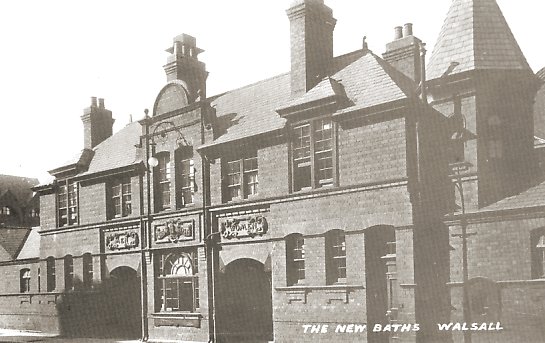
The Central Baths in Tower Street.
From an old postcard.
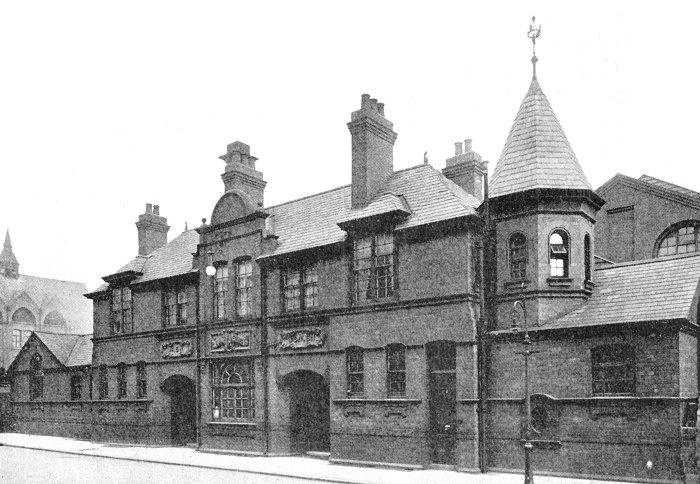
The Central Baths in 1914.
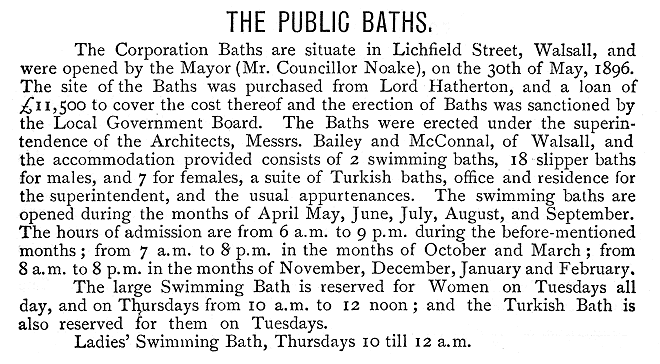
From the 1899 Walsall Red Book.
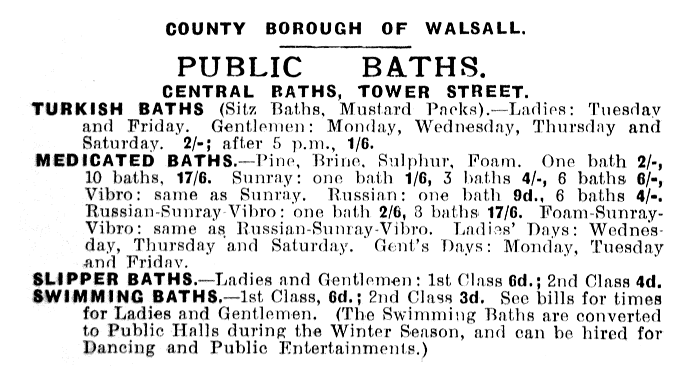
An advert from 1935.
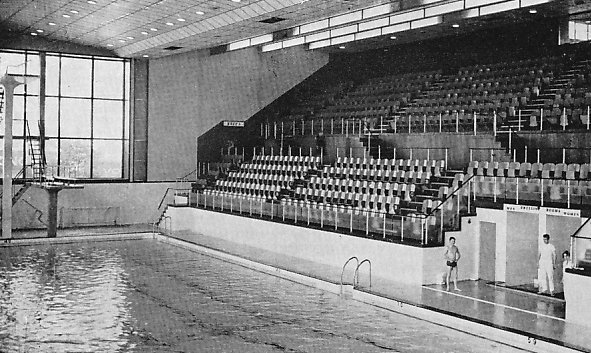
The Gala Baths in the early 1970s.
In 1922 the Corporation built an
open-air swimming pool, 75 feet long, and 36 feet wide in
Field Close, Bloxwich. Slipper baths were added in 1923, and
in 1932 a building with an overall roof was built around the
pool. There was a remedial bath service, and a covering for
the pool, so that in winter months the building could be
used for dances, plays, boxing matches, wrestling,
receptions, and parties etc.

An advert from 1935.
Slum Clearance
Walsall like most of the surrounding
towns had its fair share of slums. In 1852 and 1853 the old overcrowded
slum properties on Church Hill were demolished under the
terms of the 1824 Improvement Act which gave the Corporation
powers to pave, light, clean, and widen the streets, and to
improve the town. The old Free School and the Market House
built in 1809 were also demolished and the area around the
church was opened out.
Large scale demolition of the town’s
many slums became possible after the passing of the 1875
Artisans’ and Labourers' Dwellings Improvement Act passed by
Benjamin Disraeli's Government. The terms of the Act gave
local authorities the powers to buy slum areas, and replace
them with decent housing. The Act compelled owners of slum
dwellings to sell them to the local authority, who had to
provide compensation. The dwelling would then be demolished,
and replaced with decent housing.
Demolition began in an area of 9,000
square yards at Town End Bank, and parts of Station Street,
Wolverhampton Street, Green Lane, and Marsh Lane, which
contained some of the most squalid slum properties in the
town. The district was insanitary, and unhealthy, and some
of the residents were described as idle, profligate, with
associations that are disgusting to public morality, and
common decency. The compulsory purchase of the land cost
£17,750.
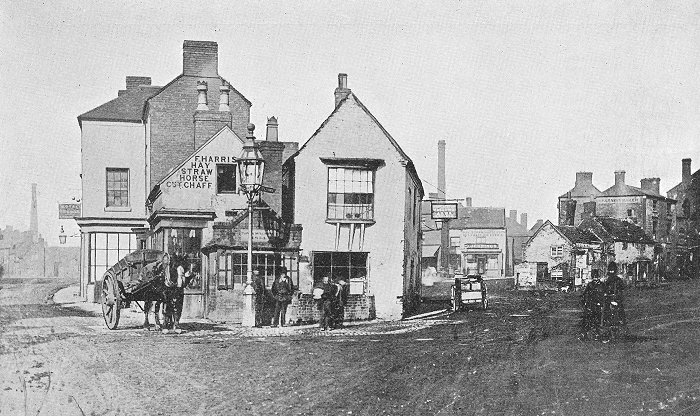
Town End Bank before demolition. From
the 1899 Walsall Red Book.
| |
Number |
|
Occupant |
Number |
|
Occupant |
Number |
|
Occupant |
|
1. |
|
John Holden |
15. |
|
William Johnson |
29. |
|
William Hughes |
|
2. |
|
John Twist |
16. |
|
Samuel Mason |
30. |
|
Jas. H. |
|
3. |
|
William Jackson |
17. |
|
William Wilkinson |
31. |
|
John Hunt |
|
4. |
|
George Harly |
18. |
|
Richard Jeffrys |
32. |
|
Joseph Lander |
|
5. |
|
Abigail Jackson |
19. |
|
Widow Spink |
33. |
|
Moses Walker |
|
6. |
|
Dorothy Holden |
20. |
|
John Spink |
34. |
|
R. Athersmith |
|
7. |
|
The Pound |
21. |
|
John Osborn |
35. |
|
Widow Johns |
|
8. |
|
Thomas Adams |
22. |
|
George Somery |
36. |
|
Edward Johns |
|
9. |
|
Elizabeth Green |
23. |
|
Thomas Lilly |
37. |
|
Thomas Nicolls |
|
10. |
|
Iona Brooke |
24. |
|
Nicholas Fly |
38. |
|
Thomas Adams |
|
11. |
|
John Palmer |
25. |
|
John Merry |
39. |
|
J. Lisby |
|
12. |
|
William Green |
26. |
|
J. Athersmith senior |
40. |
|
Thomas Fly |
|
13. |
|
Widow Lander |
27. |
|
J. Athersmith jnr. |
|
|
|
|
14. |
|
Thomas Adams |
28. |
|
Thomas Hughes |
|
|
|
In 1871 Dr. J. MacLachlan produced a
report for the Improvement Commissioners which was published
in the Walsall Free Press and South Staffordshire Advertiser
on 9th September, 1871. The report included the following
extract:
There are many buildings in the town
which are old and dilapidated and totally unfit for human
habitation. In many cases these ruinous tenements are so
close together as to constitute an obstacle to proper
ventilation; and the only remedy is to clear the ground and
let fresh air in.... The houses however, are in a
dilapidated condition and are quite unfit for the purpose to
which they are devoted. The floors are rotten and full of
crevices affording shelter to vermin and dirt.... In the
kitchen of one of them, in which there were a number of
people and in which cooking had to be done, I found a
corpse, and this is not the first time such an occurrence
has come to my notice. I would recommend the establishment
of a public mortuary to which the person dying in lodging
houses or other crowded dwellings might be removed to await
internment.
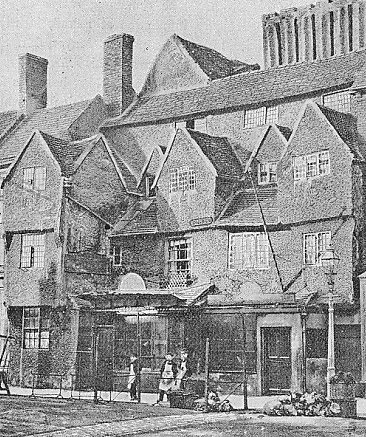
Old buildings in Digbeth. From
W. Henry Robinson's Guide to Walsall, 1889. |
| Smaller slum areas were cleared under the
terms of the 1875 Public Health Act which was designed to
combat filthy living conditions, that could lead to the
spread of diseases such as cholera and typhus.
The areas
cleared included courts and alleys in Bull’s Head yard,
Church Hill, The Ditch, Dudley Street, Peal Street, and
Lower and Upper Rushall Street.
Although some of the worst slums had
been removed, many more remained. Overcrowding and
insanitary living conditions were not uncommon, particularly
in the poorer areas, where there was still a lack of sewers,
a lack of proper drainage, and an insufficient fresh water
supply.
There would be no large scale redevelopment until
after the First World War when the 1919 Housing Act came
into force. This actively encouraged local authorities to
build new houses, and provided financial incentives. |
|
In the 1880s articles appeared in local
newspapers describing the terrible living conditions endured
by many of the poorer families. In January 1888 the Walsall Free Press
and South Staffordshire Advertiser included an article
describing the wretched conditions amongst the poor in the
Wisemore district. It gave an insight into the poor housing
conditions in the area, and the suffering endured by many.
| Read
about the poor conditions in the Wisemore
district |
 |
In 1885 to 1887 there was a serious
trade depression which affected the whole of the Black
Country and led to high levels of unemployment. The winter
of 1885 to 1886 was extremely cold and severe, and greatly
added to the suffering of the poor. A soup kitchen was
established at St. George's Road Church Schools which opened
on 13th February 1886, and operated until late March when
the snow had disappeared. Each day thirty gallons of soup,
and a small supply of tobacco was available for adults, and
whenever possible, dinners of soup and jam pudding were
given to children.
|
St. George's Soup
Kitchen
Walsall Observer - March 27th,
1886
By means of
the Soup Kitchen established at
St. George's Road Church
Schools, and worked by the Vicar
and his Committee, a large
amount of help has been given to
the suffering poor. The first
distribution was on the 13th of
February, and up to Saturday
last there had been twelve
distributions, each of thirty
gallons making a total of 360
gallons. In addition dinners of
soup and jam pudding were given
to children on six occurrences,
the number of little ones thus
being provided for being 792.
Adults dinners had been given
three times and the number
provided for was 405. To the men
present on these occasions a
small supply of tobacco had been
given out. In addition to this
dinners had been served in other
school rooms. The snow had now
disappeared but it was still
found that there were very many
in great distress receiving no
Saturday wage. It was decided to
continue the children's dinners
if the necessary funds were
supplied. |
|
Although the situation improved in the
late 1880s, things went from bad to worse in the 1890s when
a severe trade depression throughout the country resulted in
a large number of unemployed people. The depression started
in 1893 and lasted for two years, during which time the
government set up a Select Committee to investigate the
extent of distress caused by the lack of employment. Walsall
Corporation responded by giving employment to as many people
as possible who could assist in sweeping the streets, and
clearing away snow etc. Sadly this proved to be totally
inadequate, and so the Mayor, J. Noake convened a meeting of
the inhabitants and started a relief fund, based on
voluntary subscriptions. The sum of five hundred and sixty pounds was
raised, and tickets were issued to people requiring relief.
The maximum allowed to a single family was 10s.6d per week.
Loaves of bread, and grocery tickets were also handed out.
In 1893 the Medical
Officer of Health wrote a report on public health in the
town. At the time there was a high death rate of 24.42
per 1,000 of the population, and the deep trade
recession led to many tradesmen being unable to properly
support their family. The rise of poverty, leading to
poor living conditions greatly helped the spread of
diseases such as smallpox, scarlatina, diarrhoea, and
typhoid. The report concluded that overcrowding was
still a serious problem which could not be remedied
until the return to full employment.
| |
|
| Read about local
hospitals |
 |
| |
|
Newspapers
Walsall’s first newspaper, the weekly
Walsall Courier and South Staffordshire Gazette appeared in
1855, with an office in New Street. It appears to have been
short-lived, but was soon followed by the Walsall
Miscellany. In 1856 the Walsall Free Press and South
Staffordshire Advertiser came into existence. It ran until
1903 when it was taken over by the Walsall Observer.
Other newspapers appeared around the
same time including the Walsall Herald, the Walsall Guardian
and District Advertiser, the Walsall Standard, and the
Walsall News, which became the Walsall Observer. In 1857 Mr.
Robinson issued the Walsall Advertiser.
In January 1861 Walsall printer W. H.
Tomkins produced the weekly Walsall Herald, which survived
for 12 months, and in 1868 John and William Griffin founded
the weekly Walsall Observer and South Staffordshire
Chronicle which became the town’s most successful newspaper.
One hundred years later it was the town’s only surviving
newspaper. Unfortunately in the early years of the twenty
first century its fortunes wavered, the number of staff was
greatly reduced, and in 2009 its owners, Trinity Mirror,
decided to end publication.

An advert from 1896.
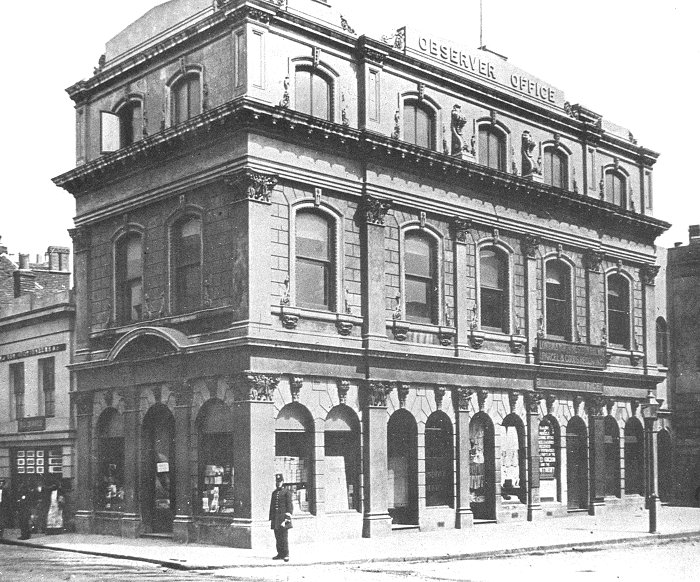
The Walsall Observer building on The
Bridge.

An advert from 1896.
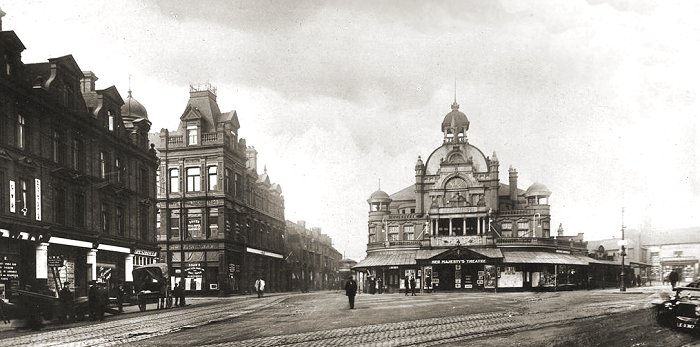
Park Street. From an old postcard.
A New Workhouse
The Poor Law Amendment Act of 1834 led
to the formation of Poor Law Unions, each with a central
workhouse. The unions were administered locally by Poor Law
Guardians who were elected by the local ratepayers, and
inspected by the Poor Law Commission, later called the Poor
Law Board.
The Walsall Poor Law Union was formed
in 1836 and operated across an area of 31 square miles,
which included the whole of Walsall, Aldridge, Bentley,
Darlaston, Great Barr, Pelsall, and Rushall. The Central
Union Workhouse was built in Pleck Road at a cost of £7,600.
It opened in 1838, and could accommodate 350 people. The
workhouse was enlarged in 1881 to cater for 464 people, and
in 1896 a separate 130 bed infirmary was added.
In 1867 Dr. J. H. Stallard produced a
damning report for the Lancet on the conditions in Walsall
Central Union Workhouse. It was published on 9th November,
and was not only critical of the workhouse itself, but also
of past inspections which had given it a clean bill of
health.
| Extracts from Dr.
J. H. Stallard's report on the workhouse |
 |
The workhouse also had facilities for
the able-bodied poor who could work in the adjacent
stone yard, or oakum sheds. The hours were long, and the work
was arduous in the extreme. Workers in the stone yard were
paid at the following daily rate in 1886:
| Single
men |
8d. |
and 2lb. of bread |
| Man and
wife |
8d. |
and 4lb. of bread |
| Man and
wife and 1 child |
10d. |
and 4lb. of bread |
| Man and
wife and 2 children |
1s. |
and 4lb. of bread |
| Man and
wife and 3 children |
1s. |
and 6lb. of bread |
| Man and
wife and 4 children |
1s. |
and 8lb. of bread |
| Man and
wife and 5 children |
1s.2d. |
and 8lb. of bread |
| Man and
wife and 6 children |
1s.4d. |
and 8lb. of bread |
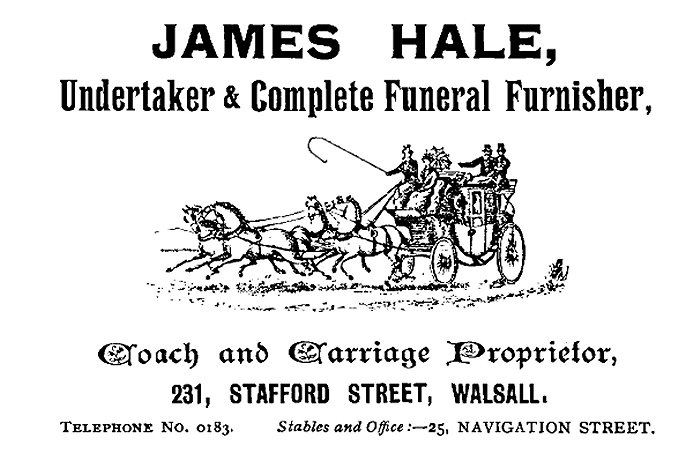
An advert from 1902.
Jerome K. Jerome
One of Walsall’s most famous sons,
Jerome Klapka Jerome was born in Bradford Street on 2nd May,
1859. He was a journalist and writer who is best remembered
for his novel ‘Three Men in a Boat’.
Jerome’s father the Rev. Jerome Clapp,
renamed himself Jerome Clapp Jerome. He came to Walsall from
Appledore, near Bideford where he had been minister of the
Congregational church. In Walsall he was an ironmonger, and
a deacon at Bridge Street Congregational Church. He later
conducted services when the congregation moved to the
assembly room in Goodall Street, and designed their new
church in Wednesbury Road.
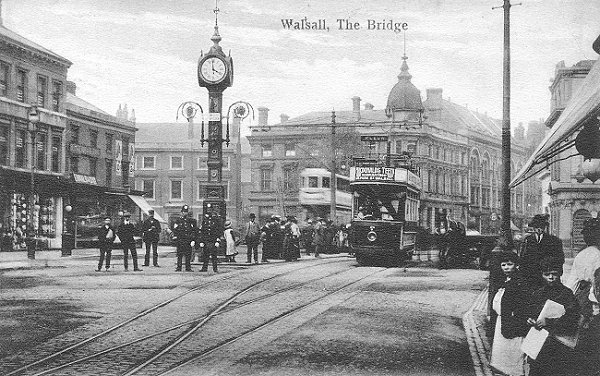
From an old postcard.
Jerome was the fourth child of Jerome
and Marguerite Clapp. He had two sisters, Paulina and
Blandina, and one brother, Milton, who died at an early age.
It was a poor family, mainly because of his father’s bad
investments. He attended St Marylebone Grammar School in the
City of Westminster, but had to leave his studies to find
work after loosing his father at the age of 13, and his
mother two years later. He initially worked for the London &
North Western Railway, collecting coal that fell from the
trains, and then unsuccessfully tried his hand at acting.
After a number of jobs, he wrote a comic memoir about his
time in the theatre, which met with some success.
In 1888 he married Georgina Elizabeth
Henrietta Stanley Marris, and along with Elsie, her daughter
from a previous marriage, they honeymooned on a little boat
on the River Thames. When they returned home Jerome
immediately began to write Three Men in a Boat, which was
published in 1889, and became an instant success. Although
he wrote many other novels, essays, and plays, he could
never recapture that success again.
In the First World War he served as an
ambulance driver in the French Army after being rejected by
the British on account of his age. Sadly his stepdaughter
died in 1921, and in 1926 he wrote his autobiography ‘My
Life and Times’.
|

The blue plaque. |
|
On 17th February, 1927 shortly before
his death, he was presented with the Freedom of the Borough
of Walsall.
In June he suffered a terrible stroke, and died
two weeks later in Northampton General Hospital.
His ashes
are buried at St. Mary's Church, Ewelme, Oxfordshire where
he had a farmhouse. Elsie, Ettie, and Blandina are buried
beside him.
Belsize House, on the corner of
Bradford Street, and Cross Street where he was born, carries
a blue plaque.
His initial K is short for Klapka,
named after an Hungarian refugee who stayed with the family
for a time, and became his father’s friend.
|
Cemeteries
By the 1850s St. Matthew's graveyard
was full, and St. Peter’s was waterlogged, so urgent action
had to be taken. The Burial Acts of the 1850s gave local
authorities the power to establish municipal cemeteries, and
so the local authority acquired around 13 acres of land in
Queen Street, and in 1857 opened Queen Street Cemetery, the
first municipal cemetery in the town. It closed in 1969 and
is now remembered as the last resting place of Sister Dora.
It is now managed by Lifelong and Community Services.
In 1873 the council acquired six acres
of land off Field Road in Bloxwich and opened a cemetery
there. It has since grown, and now covers over sixteen acres.
In 1894 the council opened another
cemetery at Ryecroft which had separate mortuary chapels for
Anglicans, Roman Catholics, and Nonconformists. A
Crematorium opened on the site in October 1955. It closed in
1984 and was replaced by Streetly Crematorium.
A New Guildhall
|
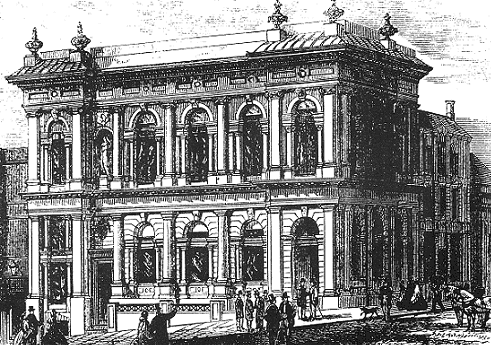
The Guildhall. From an old
postcard. |
In 1865 work began on the new Guildhall in
High Street after the demolition of the
previous building. The new hall was designed
by local architect
G. B. Nichols who
had previously worked on The Beeches Estate in West
Bromwich, and designed Walsall’s Free Library in Goodall
Street. The laying of the foundation stone
took place on 24th July, 1865. The builder was Mr. Burkitt. The building was completed
in December 1866, in time for the inaugural banquet on 1st
January, 1867. It had cost £5,308. The building, which is
Grade II* Listed has been extensively renovated. |
|
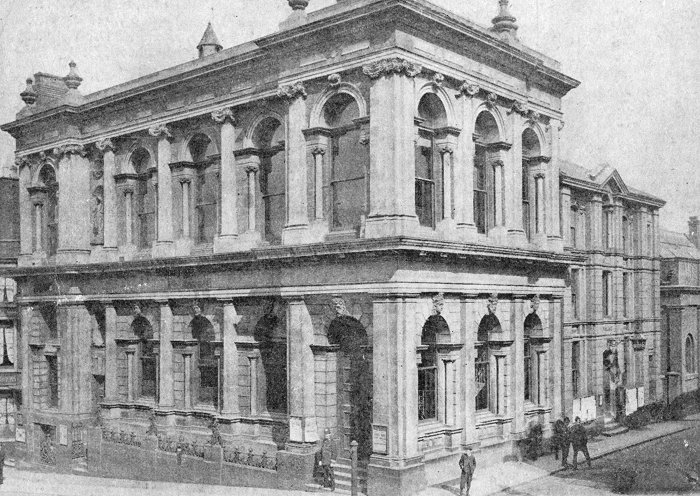
The Guildhall in about 1914.
Public Parks and Recreation Grounds in 1899:

Walsall Arboretum
Walsall’s grandest park, the Arboretum,
was set up by the Walsall Arboretum and Lake Company,
founded in 1870 to turn the area of flooded limestone pits
into an arboretum, public, and pleasure grounds. The company
had a starting capital of £4,000, and in March 1873 took a
99 year lease from the landowner Lord Hatherton for the lake
above the flooded mine workings, and seven acres of adjacent
land. The plan was to build an arboretum and gardens with
facilities for amusements such as boating, fishing, archery,
and croquet etc. There would be a lodge, a boat house, a
bandstand, toilets, and an ornamental garden through which
visitors could walk.

The Arboretum. From an old postcard.
The grand opening ceremony took place
on 4th May 1874, when the park was officially opened by Lady
Hatherton in front of 4,000 people. Unfortunately the
venture was not a commercial success, and the company went
into liquidation in 1877. Although Lord Hatherton and a
group of local businessmen took over after the company’s
demise, the venture was still unsuccessful.
Due to public demand the Council agreed to take it over as a
public park, and in 1884 purchased the freehold for £4,000.
It officially reopened on 21st July, 1884. In 1890 the
council acquired another 13 acres from Lord Hatherton to
extend the park, which were opened to the public in 1892.
|
Walsall Arboretum
and
Lake Company Limited
Terms of
Admission
| 1. |
Annual
Family Ticket, to admit subscriber
and members of his family, except
gentlemen over 21 years of age; and
also his servant when in attendance
on the subscriber or his family, but
so that
the number of persons to be admitted
by such ticket must not be more than
8. |
£1.1s.0d. |
| 2. |
Annual
Family Ticket to admit not more than
5 persons, including servant on the
above conditions.. |
15s.0d. |
| 3. |
Annual
Season Ticket to admit 2. |
10s.6d. |
| 4. |
Annual
Single Ticket. |
7s.6d. |
| 5. |
Single
Admission on all days in the week,
but one special day. |
2d. |
| 6. |
Children under 10 years of age,
accompanied by an adult. |
1d. |
| 7. |
Special
days, the prices charged to be at
the discretion of the Directors. |
|
When required, Family
Tickets will be issued to include more
persons than those above specified on
payment of 2s. for each person.
The Annual Tickets will
date from 1st of May. |
|

The Bradford Street entrance to the
Victorian Arcade in the early 1900s. From an old postcard.
Societies and
Institutions
In the nineteenth century a large
number of societies and institutions were formed to bring
like-minded groups of people together, with a common interest such as
art, literature, music, or science, and hopefully improve
the intellectual life of the town.
One of the earliest was the Walsall
Literary Society, founded in 1836. Another, the Walsall
Literary Institute, founded in 1884 was one of the most
successful, with a large number of members. It replaced an
earlier, but short-lived literary institute that was formed
in 1876 and met weekly at the Borough Club in Freer Street.
The Institute met in the Temperance
Hall in Freer Street, and provided lectures and talks given
by experts in such things as art, literature, music, or
science, and also organised social gatherings. There was
also a comfortably furnished reading room in Bridge Street,
supplied with the best periodicals and magazines. In 1891 it
moved to Lichfield Street. The Institute, which survived
until 1910, also gave grants to the Temperance Hall, and to
the Science and Art Institute.
The principal musical society in the
town was the Walsall Philharmonic Union, established in
1863. It had around 200 members and gave concerts in
conjunction with the Literary Institute at the Temperance
Hall. Rehearsals were held on Monday evenings, under the
control of the conductor, Dr. C. Swinnerton. In 1880 the
society merged with the Walsall Choral Union. Another
musical society that met at the Temperance Hall was the
Walsall Orchestral Union, formed in 1884. Meetings were held
on Tuesday evenings in the committee room.
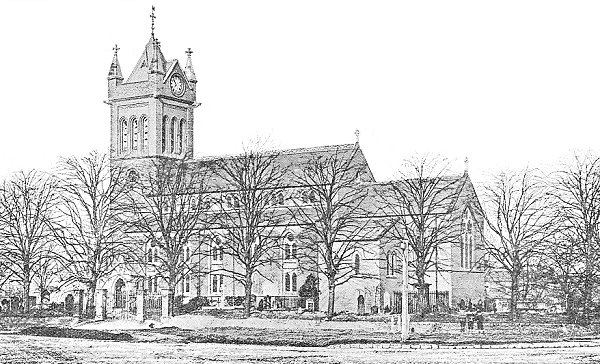
All Saints' Church, Bloxwich. From W.
Henry Robinson's Guide to Walsall, 1889.
Another society that promoted art,
literature, music, and science was the Institute Society,
formed in 1883. Meetings were held at the Science and Art
Institute, and present and past students were encouraged to
join. The society met on the second and fourth Thursday in
each month to listen to a lecture, or a paper given by one
of the members, followed by a discussion on the topic.
Horticulture was not forgotten. The
Florist Society formed in 1879 attempted to encourage the
growth and cultivation of flowers, fruit, and vegetables
amongst the working classes. It held an annual exhibition in
St. George’s Hall that attracted a lot of entries. In 1888
there were 681 entries, and £41.18s.6d. in prize money.

Walsall in 1889.
Chamber of Commerce
The Walsall Chamber of Commerce held
its first meeting on 2nd September, 1881. It has done much
for the trade of the town, and in its early years used its
influence to improve the postal service, to oppose increases
in railway rates, and to promote parliamentary schemes that
benefitted local industry. In the 1880s it was managed by a
president and council consisting of sixteen elected members.
Further Education
Early examples of further education
classes were the mutual improvement classes run by groups
such as the Bridge Street Mutual Improvement Society, formed
around 1860 to run classes in the schoolroom of Bridge
Street Congregational Chapel, the Walsall Wesleyan Mutual
Improvement Society, the Walsall Church of England
Institute, and the Butts Working Men's Institute. There was
also the Ablewell Street Science Institution which used the
schoolroom in Ablewell Street Wesleyan Methodist Chapel.
Technical education began in 1854 with
the formation of the Walsall School of Design and Ornamental
Art, founded by local sculptor, W. Smith. 1869 saw the
formation of a Government School of Art in Bridgeman Place,
which in 1871 moved to rooms in Railway Chambers, Station
Street. In October 1872 the school merged with the Ablewell
Street Science Institution to form the Walsall Science and
Art Institute, with Sir Charles Forster, M.P., as President.
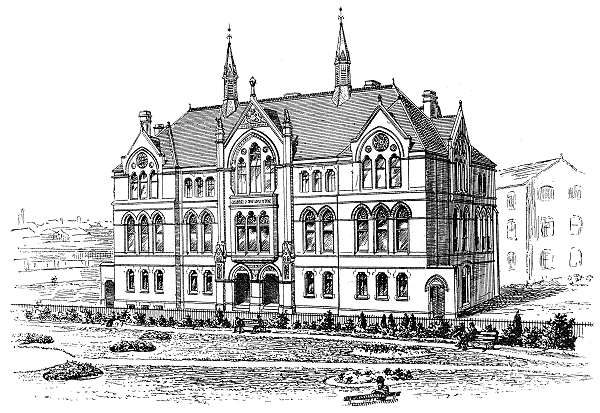
The Science and Art Institute. From W.
Henry Robinson's Guide to Walsall, 1889.
|
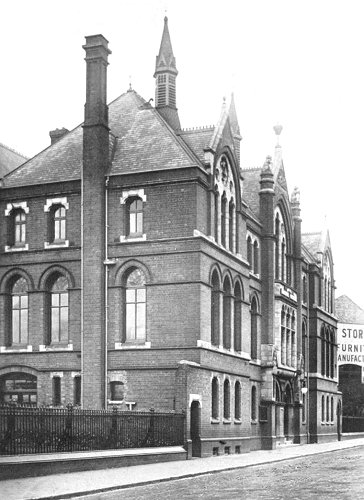
The Science and Art Institute. From an
old postcard. |
The institute struggled for some years
with insufficient funds, but help was at hand in 1887 thanks
to an unconnected gesture by the Prince of Wales, who
championed the building of a grand institute in London, to
be known as the Imperial Institute. Walsall’s Mayor, William
Kirkpatrick, wanted to emulate the Prince’s example by
building a grand institute in Walsall to commemorate Queen
Victoria's golden jubilee. He knew about the plight of the
Science and Art Institute, and suggested that a suitable
building should be erected in the town to house the
institute.
Land in Bradford Place was given by
Lord Bradford, and the foundation stone was laid on Jubilee
Day, 20th June, 1887 by the Mayor. The attractive and nicely
balanced building was designed by Dunn and Hipkins, of
Birmingham, and cost around £6,000. The opening ceremony, on
24th September, 1888 was performed by local M.P. Sir Charles
Forster, ably assisted by the Chairman of the Building
Committee, Alderman Holden, J.P.
A technical day school for boys was opened at the institute
in1891. It had 52 pupils.
|
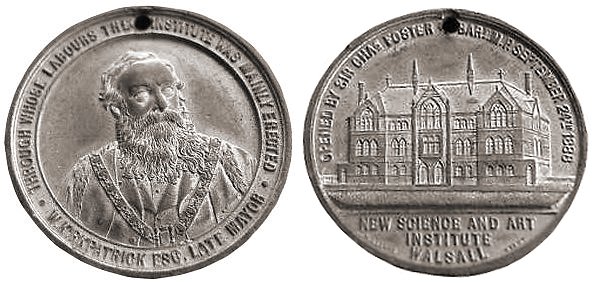
The commemorative medallion,
celebrating the opening of the Science and Art Institute.
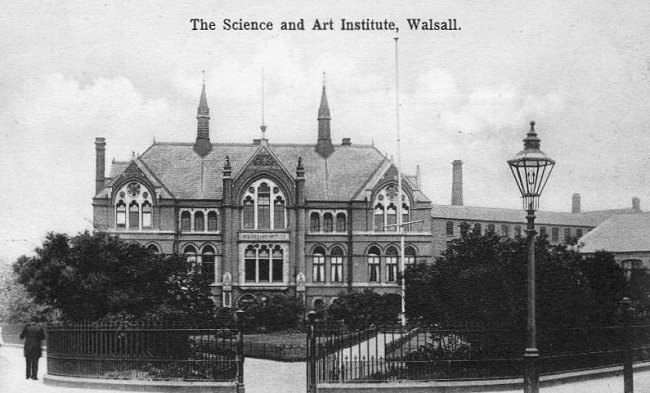
From an old postcard.
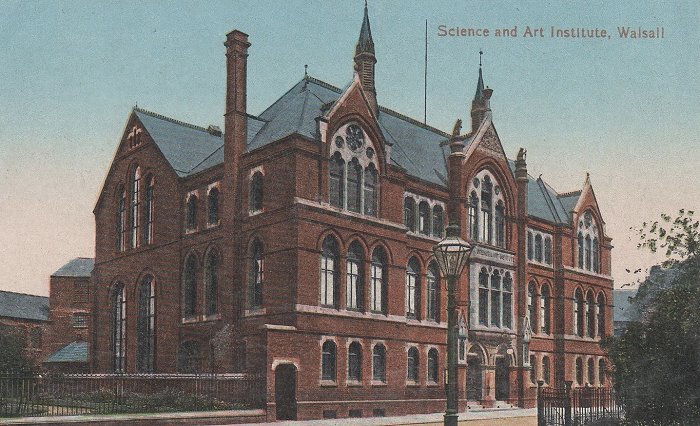
From an old postcard.
On 31st August, 1897 the institute was transferred
to Walsall Council and became the Walsall Municipal Science
& Art Institute. Eleven years later it moved to Goodall
Street, and in 1926 became Walsall Technical College.

From the 1934 Walsall Red Book.
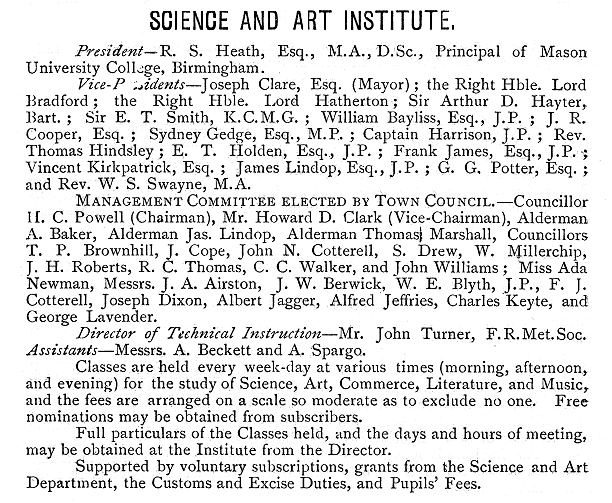
From the 1899 Walsall Red Book.
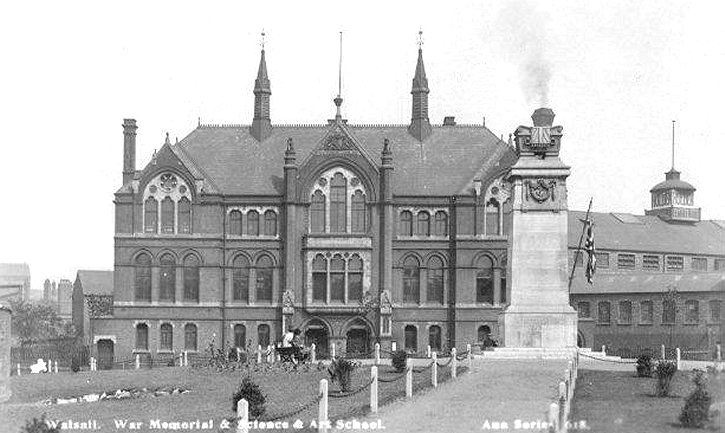
From an old postcard.

The science laboratory in about
1910.
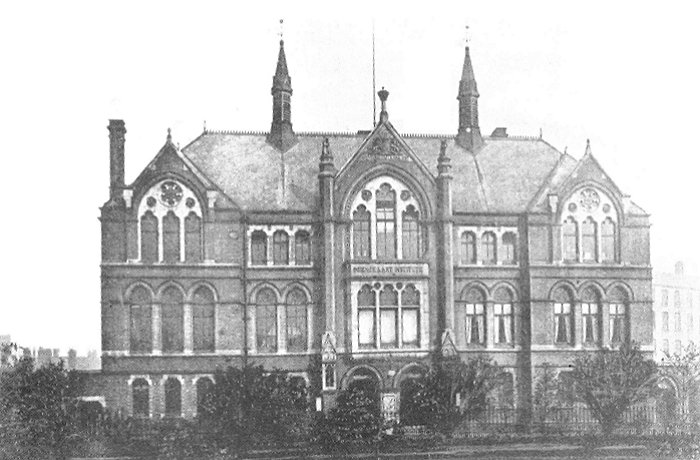
The Science and Art Institute.
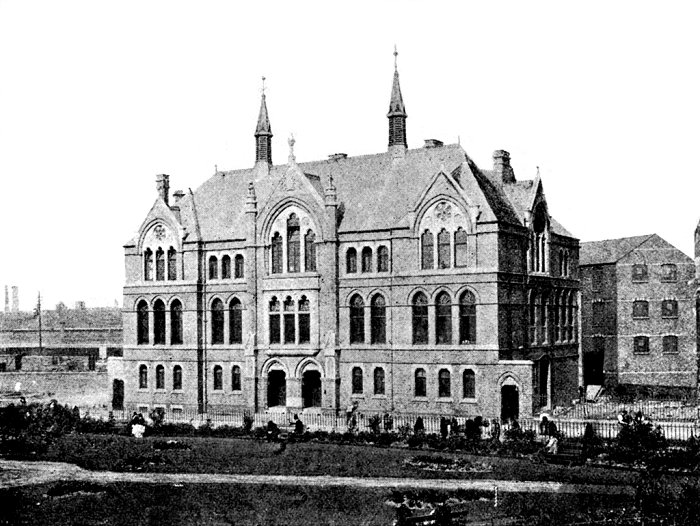
The Science and Art Institute in about
1914.
| |
|
Read about the
Walsall Anarchists |
 |
| |
|
|